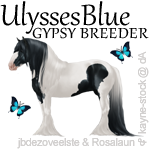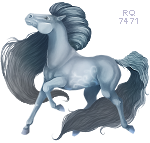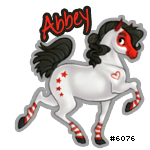|
#114425 Posted on 2017-07-16 06:21:25
I've noticed that some of the horse art for certain colours or markings is inaccurate, or at least very atypical. I just thought I'd make a list of any issues in the hope that the relevant art/code can one day be revamped, or at least serve as a list of things to look into further. I'm not requesting these changes necessarily happen any time soon, just documenting any issues that may exist. Feel free to add to it, or correct any items on this list if I'm mistaken. This list is NOT for colours or patterns which are missing from certain breeds (which should be suggested here instead), or for those which aren't in the game at all. It's just for those which are already present but contain errors.
Silver
1. Silver is a dilution, not a white marking. It changes black manes and tails to a blonde or white colour, and black body pigment to a chocolate brown. Red based pigment is unaffected. So a silver black horse will have a chocolate body and pale mane/tail, while a silver bay horse will have chocolate coloured points, pale mane/tail, but the usual red body of a typical bay. Buckskins, duns, etc with silver will have the black based parts diluted in a similar manner, and the red based parts unaffected. See here for some examples of silver with a variety of other genes. At the moment the art displays as a sort of dappled roan that is overlaid the existing art in the same way as other white markings (and also affects bays and blacks in the same way, when the red part should instead be unaffected in bays). It instead needs to be individual artworks, same as the cream, champagne or dun variants.
2. Silver is also a simple dominant, i.e. Zz and ZZ looks the same. We can ignore this for the purposes of having more variety in colours, however if the silver overlay gets replaced with individual artworks for the different silver variants then it would probably be better to include this just to cut down on the amount of new art that has to be produced.
White markings on grey
1. The current code makes the white markings vanish once the horse has greyed out past a certain point. They should probably stay put instead. The main difference is that white markings have pink skin, while grey usually has black skin. The difference between the white and fully greyed out parts of a horse's coat can range from subtle to something quite striking and pretty. This modification wouldn't require any new art, just a code change.
Bonus: Perhaps as part of this we could make the final grey stage a 90% opacity version of light grey over the usual base colour, so that there's a little more contrast between the white and grey, while still remaining quite subtle.
Double sabino plus any other white markings
1. Double sabino (SbSb) produces a horse which is almost completely white. If another pattern is added to this the horse should be more white, not less. Currently horses with double sabino plus another pattern sometimes end up with the same art as horses with single sabino plus the other pattern, i.e. show much more colour than double sabino on its own. I would suggest this is changed to one of the following:
a) SbSb plus another marking displays as the SbSb art and the other marking art on top of each other as separate images, i.e. there's no interaction between the genes. This would require no additional art, just a code modification.
b) SbSb plus another marking displays the same as solid white. Most breeds with sabino already have art for solid white or don't have this issue, so this solution would require a code modification and only one new image (solid white Welsh Pony).
Tobiano
1. The current art for single tobiano (T+) shows a very atypical tobiano. Although technically not impossible, it's extremely rare for tobiano to look like this. The art for double tobiano (TT) is more characteristic of tobiano, but also contains some inaccuracies. For example, tobianos almost always have white legs, at least to the knees. I suggest replacing the T+ art with the TT art, and modifying it slightly to add more white on the legs, then producing new art for TT tobiano (if it's necessary to have different art for T+ and TT). Homozygous and heterozygous tobiano look pretty similar, but it's said the homozygous ones have ink spots and haloing like that seen in this confirmed TT horse. Not sure if this is confirmed though.
Sabino in Clydesdales
1. In real life the marking known as sabino which occurs in Clydesdales is not Sabino 1 (what we call sabino on EV). It's something else, which typically looks like this. It causes socks/stockings on all legs, and a prominent blaze on the face. The most extreme form of it includes some roaning across the body, which is hypothesised to be the homozygous form. The nearly completely white type of homozygous sabino seen with Sabino 1 is never seen in clydes. I'd like to suggest the two sabino images for clydes be revamped. This doesn't affect any other breeds.
Dominant White
1. There are lots of different dominant white genes - some are solid white, some are sabino-like, and some are very minimal (e.g. W20). On EV we only have one W gene, which appears to be equivalent to whatever type of dominant white is present in each respective breed, i.e. equivalent to several different W genes. As far as I can tell, several of the breeds on EV which have the W gene do not have the solid white type of dominant white in real life, but instead have one of the other kinds. I'd like to suggest those breeds have their white art replaced. I'm fairly certain this issue affects gypsy vanners (they have W20, which is just socks and a blaze). Quarter Horses, Paints, Appaloosas, and possible others have one of the sabino types of dominant white. I have a detailed post here about dominant white in EV breeds.
Buckskin and dun
1. Dun markings are lacking a lot of their most characteristics features. Some colours/breed combos show no leg barring. All seem to be missing other dun features such as the darker face or 'face mask', shoulder barring, etc, although these don't always occur on duns.
2. Cream does not cause any primitive markings, but leg barring can be seen on buckskins of the following breeds: mustang, paint, thoroughbred, trakehner.
3. Buckskin, classic dun and dunskin tennessee walking horses seem to be missing the dark legs of other buckskins, classic duns, and dunskins. Instead they have a largely uniformly coloured coat.
Overo
1. The overo markings are very atypical in TWH, chincos, mustangs and shetlands.
Splashed White
1. The Splashed White gene always causes blue eyes, without exception. This is regardless of how small or large the white markings are, or where they're located. Some of the splashed white markings on EV have brown eyes. The artwork that needs to be changed to have blue eyes includes:
Splash1: appaloosa, gypsy vanner, miniature horse, mustang, paint horse, shetland pony, tennessee walking horse.
Splash2: appaloosa, mustang, paint horse, shetland pony, thoroughbred.
Frame-splash: appaloosa, mustang, paint horse, shetland pony.
Tovero-splash: appaloosa, gypsy vanner, miniature horse, mustang, paint horse, quarter horse, shetland pony, tennessee walking horse.
Sabino-splash: appaloosa, chincoteague, gypsy vanner, miniature horse, paint horse, shetland pony, tennessee walking horse.
That's all the issues I'm aware of for now. Feedback appreciated.
Last edited on 2017-08-11 at 05:19:59 by UlyssesBlue
1 members like this post.
|
Posted By

UlyssesBlue
#60734
 
Member is Offline
922 forum posts
Send A Message
|
|
#114518 Posted on 2017-07-16 18:17:52
@Rising Dawn
I've been through some of the breed art, and it does look like some duns are lacking primitive markings, while others are fine. Could you clarify which breeds/colours are affected? Could you also give an example of a buckskin with primitive markings?
Overo in TWH does seem pretty strange. The issue also seems to affect chincos, mustangs and shetlands. thanks for pointing that out.
@Champagne
Yeah, they look more like overos. One of the main characteristics of Tobiano is the white legs. The rest of the marking is actually fairly accurate, so if the legs are just change it'll be fine.
@maine
Gypsy Vanners have both sabino and blagdon, with the former confirmed by genetic tests, so their sabino art is accurate. Blagdon is likely to be the draft-type sabino found in clydes, or else W20, which has also been confirmed in gypsies with genetic tests. To include blagdon we could perhaps make the W gene in gypsies mimic W20, which I suggest under the Dominant White section in my first post. I can't find any evidence suggesting they have another type of dominant white gene, so this would make sense.
0 members like this post.
|
Posted By

UlyssesBlue
#60734
 
Member is Offline
922 forum posts
Send A Message
|
|
#115797 Posted on 2017-07-28 04:03:37
Sure. :) It'll take me a little while to put that together so this list won't be 100% complete just yet. If anyone could help me out with some suggestions or corrections please post below and I'll check it out.
Silver
Note that this only affects black based parts of the coat, so chestnuts and the red based part of bays will be unaffected. The mane/tail tends to be strongly diluted, however can darken with age so while most of the examples below show the characteristic pale mane/tail, a few do not, and this is probably just because they're much older, so this shouldn't be considered typical.
Silver black: body is dark brown, mane/tail are flaxen, blonde or white. Body may or may not be dappled. example1 example2 example 3 example4
Silver bay: lower legs are diluted to the same colour as the body of a silver black. Red part of the body unaffected. Mane/tail are the same as on a silver black. example1 example2 example3 example4
Silver smoky black: chocolate coloured body, flaxen mane/tail. example1 example2
Silver buckskin: lower legs are same colour as silver smoky black coat. Yellow (red based) part of coat unaffected. Flaxen mane/tail. example1 example2
Silver grullo (black + silver + dun): example showing silver black on left and silver black dun on right, same horse seen from the side, example2
Bay dun silver: example1
Classic cream silver (cream + champagne + silver): example1
Amber champagne silver: example1 example2 example3
Could someone help me out by listing all the possible silver combinations?
Tobiano
Heterozygous: All four legs will be white up to at least the knees, usually higher. Marking on hind legs extends up back of legs and rump to back in a characteristic C-shape. It does not cause face markings, so any blazes, etc, in these images are due to something else. example1 example2 example3 example4
Homogyzous: similar to above, but often has 'ink spots'. All these examples are confirmed TT. example1 example2 example3 example4
Last edited on 2017-07-28 at 04:19:51 by UlyssesBlue
1 members like this post.
|
Posted By

UlyssesBlue
#60734
 
Member is Offline
922 forum posts
Send A Message
|
|
#115915 Posted on 2017-07-29 03:59:32
@Abbey
If we can't overhaul silver completely I think it would still be possible to get it to work with the existing layering system. I definitely think it would be a good idea to have a bay-type silver that's different to the black-type silver to account for the red parts of the coat being unaffected. In addition to this, the Zz and ZZ silver files could be modified to better duplicate how silver looks, perhaps like this:
Zz silver:
- Mane and tail pretty much identical to our existing flaxen art (i.e. very pale, off-white colour, entire mane/tail affected). Note that the current silver art in which the mane/tail colour is a gradient from the roots down is uncharacteristic of silver.
- Body is uniformly covered in a light yellow/orange colour set to high transparency so that most of the base coat shows through. This will mimic a slight dilution effect across the entire coat.
example1 example2 example3
ZZ silver:
- Mane and tail as above.
- Body similar to above. In addition to this, have dapples in the same light yellow/whatever colour, but set to be less transparent so less of the base coat shows through, i.e. the dilution appears stronger.
example4
I've experimented with some of the art files and I found that a solid layer of colour #F1DAC9 set to 10% opacity over the body, with dapples in the same colour set to 30% opacity, seemed to do a reasonable job of mimicking the effect of silver on a number of different base coats. Hope this helps.
White markings on grey
I'm assuming no image references are needed here since there's no changes to art, just the code?
Double sabino plus any other white markings
Ditto. It's just solid white. We already have the art for this for all but the Welsh Pony, just under the name White.
Tobiano
(I'm just going to copy-paste what I wrote earlier so that we have everything in one post.)
Heterozygous T+: All four legs will be white up to at least the knees, usually higher. Marking on hind legs extends up back of legs and rump to back in a characteristic C-shape. It does not cause face markings, so any blazes, etc, in these images are due to something else. example1 example2 example3 example4
Homogyzous TT: similar to above, but often has 'ink spots'. All these examples are confirmed TT using genetic testing. example1 example2 example3 example4 example5
Clydesdale Sabino
Heterozygous Sb+: A broad blaze, with 4 high socks or 'triangular' stockings. example1 example2 example3 example4
Homozygous SbSb: It's speculated that the homozygous form causes more extensive white markings, including some white spotting across the body, primarily on the belly. I'm not certain, but I think the very roany type might either be an extreme version of this, or else a separate gene altogether. I'll post both types and let you decide what you want to do. example1 example2 example3 example4 roany type: example1 example2
Dominant White
If I've understood you correctly this won't be altered? Let me know if it will and I'll come back to this.
Work in progress. Still to do: Buckskin and Dun, Overo
Last edited on 2017-07-29 at 04:03:05 by UlyssesBlue
0 members like this post.
|
Posted By

UlyssesBlue
#60734
 
Member is Offline
922 forum posts
Send A Message
|



















